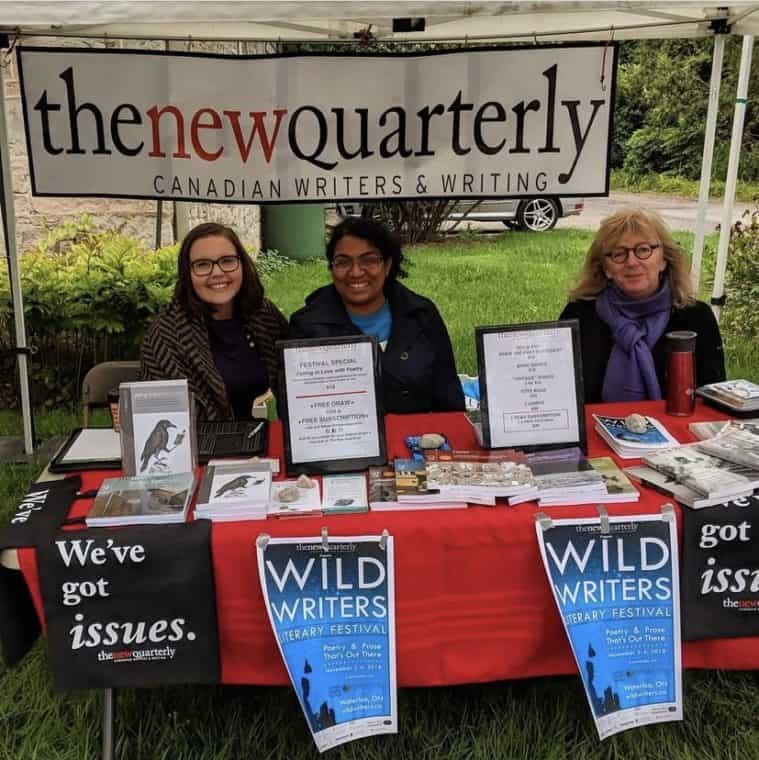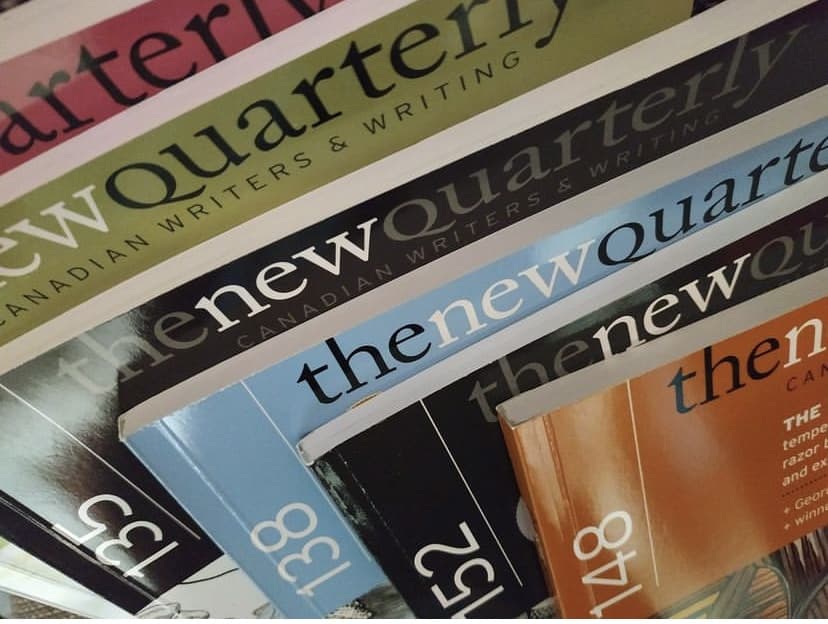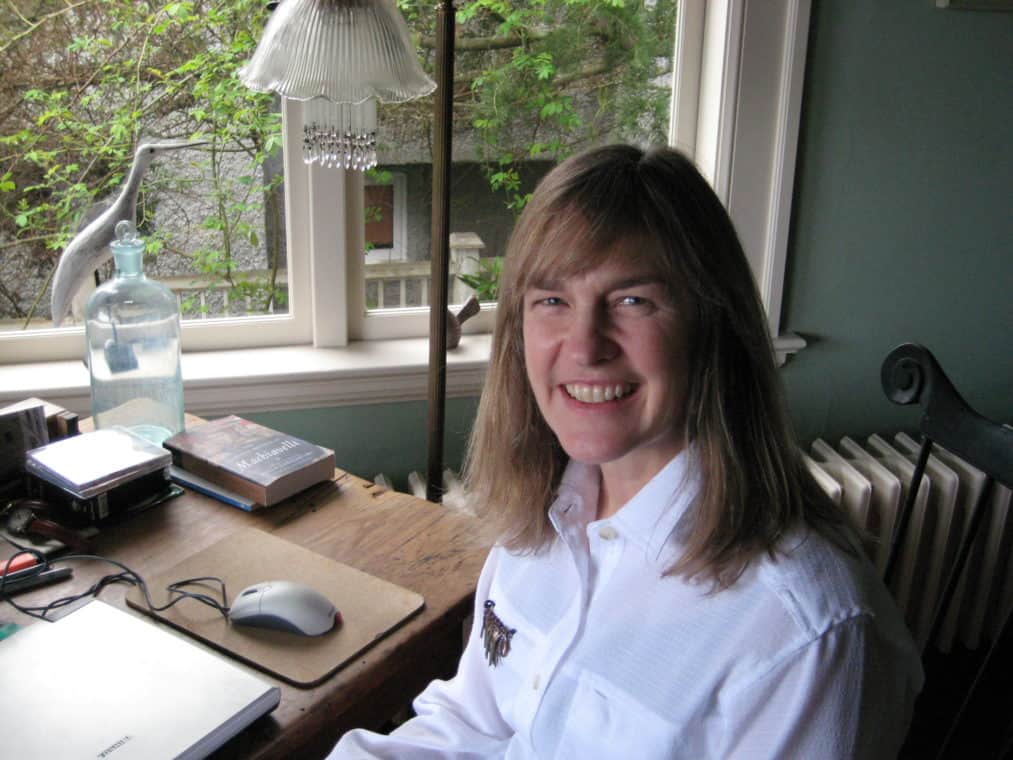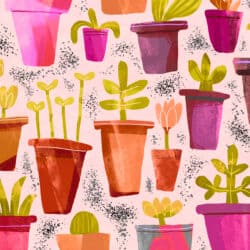Artist Isabella Stefanescu’s essay about volunteering in the arts focuses on Kim Jernigan’s work with The New Quarterly as a pivotal example. As with other sectors, volunteering in the arts, where volunteers often sign up for the long haul, has been losing ground, and the pandemic has further disrupted volunteering at a time when the cultural sector is facing historically high job vacancies.
Art – work
In a country that now regards money as the highest good,
doing something for the love of it is not just odd, but downright perverse.
—Charles Simic
Some years ago, toward the end of the last century, a friend was discreetly approached by her first-grader’s teacher, who asked whether her husband had found work. My friend was nonplussed. The teacher explained that on the first day of school, when she went around the classroom asking each child to talk about what their parents did for a living, the boy had said, “My dad does not work. He sits around at home and draws pictures …” Our friends had to sit their son down and explain that drawing is indeed work.
The child’s and the teacher’s misunderstanding is not all that surprising: in a world where a developer describes his proposed project as a place to live, work, and play, making art is more likely to end up in the play category – the making of pictures and theatre, the singing, the dancing, the part that has to do with leisure, entertainment, display and decoration, the extra, a way of disposing of disposable income, and perhaps itself disposable.[1]
This is perhaps why making art does not necessarily mean making a living.[2] Some artists are uncomfortable with the idea that works of art are a commodity and can be bought and sold, or monetized, to use the contemporary jargon. For some artists, making art is a calling and the making is its own reward.[3] This is often made possible by other means: help from parents or spouses, private wealth or trust funds, grants or residencies, or the proverbial day job – teaching, waiting on tables, cleaning houses, or working in the arts.
Working in the arts, as distinct from making art, is a form of work that Ivan Illich called shadow work, “the toil that is associated with (and preparatory to) the act of consumption.”[4] It is definitely work, and even a first-grader might identify it as such. But like housework, working in the arts is often invisible, the submerged part of the iceberg, part of the nether economy. Like housework, it starts as a labour of love, unpaid and uncounted, and a great deal of it is done by women.[5]
For any work of art to reach a public, here is some shadow work that needs doing first: fundraising, editing, installation, cleaning, documentation, contracts, bookkeeping, reporting – all transparent to the public; ticket sales, registrations, ushers, receptionists – necessary but not essential. Until recently, in a subsistence economy, artists used to do it all themselves, but in the last couple of centuries artists have become either the clients or the employers of arts workers. At its most visible, working in the arts is a kind of frame: curating, promotion, publishing, and writing the context – the labels, the introduction, the catalogue essay, the website, the review, the history. And then there is education and engagement – the tour, the festival, the talk-back show.
Many arts workers start out as volunteers.

A labour of love
Works of art are of an infinite solitude,
and no means of approach is so useless as criticism.
Only love can touch and hold them and be fair to them.
—Rainer Maria Rilke[6]
“TNQ (SAY IT THREE TIMES QUICKLY…)” is a quote from the thank-you page of The New Quarterly. The punning gratitude – said quickly, “TNQ, TNQ, TNQ” turns into “thank you, thank you, thank you” – acknowledges, among others, “our many volunteers extraordinaire, both in the editorial ranks and in the office.”[7]
The New Quarterly is a literary journal that does not publish criticism. It started in 1981 as a stapled mimeographed brochure, with $3,000 from Edna Staebler, Farley Mowat, and Harold Horwood, plus a bit of start-up money from the University of Waterloo’s St. Jerome’s College, where Horwood was writer-in-residence. Kim Jernigan joined The New Quarterly team as a volunteer while still an MA student – eight months pregnant, she collated the second issue of the magazine sitting on the floor. In 1984 Jernigan took over from Horwood, not as writer-in-residence, but as editor, a volunteer position.
I met Jernigan in 2001, exactly at the inflection point when the labour of love was starting to wear thin. For almost 20 years, she had worked for TNQ pro bono, curating, editing, coordinating, leading a team of volunteer editors, fundraising, and doing anything that needed doing to keep the journal alive. She got her children involved in helping out, and occasionally her husband footed the printer’s bill. The work for TNQ started “gradually squeezing out much of my paid work, but the gratification of watching writers mature and feeling like I’ve been part of that in some small way is significant,” she later recounted with characteristic modesty.[8] In 2001 TNQ was groaning under its own success, and Jernigan was desperately looking for funds to hire a managing editor. And she realized that succession would be a huge problem.
It is exactly at this point that many organizations die. The transition from a transformational leader is difficult, but how much more difficult when that leader had worked 20 years without pay, and when, as is often the case, that donation-in-kind, the equivalent of a full-time salary, was not reported in the financial statements. It took 10 additional years of hard work before TNQ could stand on its own two feet.
The New Quarterly incorporated as a not-for-profit in 2002 and acquired charitable status in 2011. During Jernigan’s tenure as editor, TNQ was nominated for 44 National Magazine Awards, winning eight gold and six silver medals. After issue number 123 was published, in the summer of 2012, Kim handed over the editorial reins to Pamela Mulloy. The editor’s job was by then a paid position.[9]

The rectangular world
It’s a perfectly square magazine
making its way in a rectangular world.
—Alexander MacLeod, describing The New Quarterly
Making art, no matter how generous the impulse, is not an activity with charitable ends. However, much of the shadow work in the arts is considered charity, especially the framing kind of activities which can be slotted in with education.
In the Giving Report 2022, Canada Helps states that 58% of Canadian charitable organizations are entirely run by volunteers.[10] Most arts organizations fall within the 90% of charities that have fewer than 10 employees. This does not include the not-for-profits without charitable status or the unincorporated non-profit organizations and artists’ collectives.
In all sectors the top 10% of volunteers tend to be very engaged, donating more than half of the total volunteer hours. But in the arts, volunteers sign up for the long haul: 39% of volunteers stay with the same organization for at least five years. Most arts volunteers are in leadership positions, organizing, supervising, and coordinating activities.[11] In 2013, the last year with detailed data for the arts and culture sector, the average cash donation per donor per year was $159. Compare this with the work donated by the average volunteer – 120 hours per year, the equivalent of $2,109.60.[12] But volunteering in the arts has been losing ground, going from an average of 120 hours per volunteer per year in 2013, more hours than in any other type of organization,[13] to 104 hours per volunteer per year in 2018, dead last of all the sectors. Moreover, the youngest segment of the population volunteers only about a third as much as baby boomers.[14]
The pandemic has deeply disrupted volunteering[15] at a time when the cultural sector is facing historically high job vacancies. It does not help the arts employment situation that the average hourly rate is the third lowest (after accommodation and food services, at the bottom, and retail, the second lowest).[16] And even before the pandemic, workers in the arts were experiencing “rampant” burnout.[17]
Just a way of living
Art too is just a way of living, and however one lives,
one can without knowing, prepare for it; in everything real
one is closer to it, or its neighbour, than in
the unreal half-artistic professions …
—Rainer Maria Rilke[18]
Volunteering in all sectors comes at a cost that is not borne by the person who makes a simple cash donation. At its most trivial level, an average donor giving $159 a year to an organization would get a bit of it back at tax time, and would probably have their name listed in a brochure, a program, or on the organization’s website. An average volunteer donating $2,109.60 worth of work not only forgoes a tax break, but is often one of those who are “too many to name.”
And for the heavily invested volunteer, the donated work squeezes out paid work and other opportunities. Time passes, doors close. After finishing her MA in English while editing The New Quarterly, Jernigan started a PhD: “I got as far as the pre-dissertation oral, intending to write about Alice Munro. My committee was positive about the project but by then I had three children, a part-time job in the University’s writing centre, and a literary magazine on the go that likely wouldn’t survive without me.”[19]
There is one cost that is specific to people working in the arts: the tensions between those making art and those doing the shadow work, between the creators and the presenters, the art-makers and the framers. There is the perception that working in the arts, as opposed to being an artist, is not quite the real thing. For a volunteer in a non-board leadership position there are kudos for their generosity, yes, but also a whispered stigma attached to working for free.
This tension turns into inner conflict when an arts worker is also an artist. Not only is working in the arts not the real thing, but it contaminates the mental space where the art-making happens. Rilke’s words – the unreal half-artistic professions – are like a sharp pebble in your shoe.
“My mother is not someone who edits because she can’t write: she is someone for whom editing is a true vocation,” says poet Luke Hathaway,[20] the baby waiting to be born as Jernigan, on hands and knees, was collating the second issue of TNQ, in which three of her own poems were being published.
But almost 40 years ago, Harold Horwood saw something else that was special in Jernigan: “He recognized a responsibility junkie.”
The New Quarterly is a keystone species, an organization that introduces diversity in the cultural ecosystem,[21] to use the “rewilding the arts” metaphor developed by David Maggs in Art and the World after This.[22]

A sense of possibility
To pass through open doors, it is necessary
to respect the fact that they have solid frames.
—Robert Musil[23]
At the end of March 2020, I saw a deer cross King Street, downtown Kitchener’s main thoroughfare. The deer bounded gracefully from the First Mennonite Cemetery, over the normally busy road, into the scrubby woods beside a footpath that is not yet an official city trail, and disappeared. It was noon and there was nobody else on the street. We had been forced to pause, and in that pause the rest of the world came back in.
The sight filled me with wonder, and in the middle of fear and uncertainty it pointed to possibilities, to things that we could dream of and make real. Shadow work became visible during the pandemic, and those of us who were already working in the gift economy[24] found that we could function rather well in a crisis.
As we are coming out on the other side, I have been thinking of those 10 years – from 2002 to 2012, from the year The New Quarterly was incorporated to the year in which Kim Jernigan stepped down – and wonder: could things have happened otherwise? Could we imagine another kind of past, in order to fashion another kind of future? For love is a hard task master, as Luke Hathaway writes, and
… what he wants is always something
Other than what we volunteer.[25]
[1] Books trying to persuade us of the indispensable value, benefits, and importance of the arts appear with some regularity. A recent example is Authority and Freedom: A Defense of the Arts, by Jed Perl, Alfred A. Knopf, New York, 2021.
[2] In 2016 the median income of artists in Canada was $23,400, calculated using 2016 census data. Hill Strategies, A Statistical Profile of Artists in Canada in 2016 (With Summary Information about Cultural Workers), November 2019. Figures using the 2021 census data are not yet available.
[3] “Poets and Money” by Charles Simic, New York Review of Books, August 12, 2012.
[4] Ivan Illich, Shadow Work, Marion Boyars, Boston/London 1981. The definition I use here is from Gender, Pantheon Books, NY 1982, p. 45, note 30.
[5] 58% of arts volunteers are women, Hill Strategies reports in Volunteers and Donors in Arts and Culture Organizations in 2013, February 3, 2016. In leadership positions, three-quarters of library, archive, museum, and art gallery managers are women, and two-thirds of curators and conservators are women. But women are underrepresented in the leadership positions involved in the making of art – only 35% of producers, directors, choreographers and only 31% of composers and conductors are women. Women in Arts Leadership Positions, December 13, 2022.
[6] Rainer Maria Rilke, Letters to a Young Poet, translated by Stephen Mitchell, 1984, Modern Library Edition, New York 2001, p. 23. This is also the epigraph of Brick, a Canadian based literary journal.
[7] The New Quarterly – Canadian Writers and Writing, Number 164, Fall 2022, p. 137. Some of the volunteers extraordinaire are named in the masthead.
[8] In a profile that was published in November 2010, by the University of Waterloo English Department, as part of its “English at 50” celebrations.
[9] TNQ is thriving. The latest issue, edited by Pamela Mulloy is TNQ 165, Winter 2023.
[10] “Giving at a Crossroads,” the 2022 Giving Report, p. 5.
[11] Hill Strategies, Volunteers and Donors in Arts and Culture Organizations in 2013, February 3, 2016.
[12] Ibid.
[13] Ibid.
[14] Statistics Canada infographic, Volunteering by Canadians in 2018.
[15] In spring of 2020, for example, 56% of people who applied to volunteer at an organization did not hear back, and 40% of organizations suspended all volunteer activities (Volunteer Canada infographic, Spring 2020 Organization Survey Results).
[16] Kelly Hill, “Labour Force Challenges Continue in the Arts,” January 17, 2023.
[17] Work in Culture, Making It Work: Pathways Towards Sustainable Cultural Careers, May 2019, p. 52.
[18] Rainer Maria Rilke, Letters to a Young Poet, translated by Stephen Mitchell, 1984, Modern Library Edition, New York 2001, p. 108. The quote is from the 10th and last letter, “Paris, Christmas Day, 1908.”
[19] Kim Jernigan (MA 1981), November 2010, University of Waterloo English Department.
[20] Luke Hathaway, the former Amanda Jernigan, speaking with Robert Taylor in “Caught Unawares at the Centre: An Interview with Amanda Jernigan” in PRISM International: Contemporary Writing from Canada and the World, September 13, 2018.
[21] TNQ launched the Wild Writers Literary Festival in 2012, then a series of literary competitions that are judged blind, and has mentored Textile, a magazine “that showcases the diversity of Waterloo Region.”
[22] David Maggs, Art and the World After This, Metcalf Foundation, 2021, p. 54.
[23] Robert Musil, The Man without Qualities, translated by Sophie Wilkins, Alfred A. Knopf, 1995, Vol.1, p. 10.
[24] Lewis Hyde, The Gift: Imagination and the Erotic Life of Property, Random House, 1983.
[25] Luke Hathaway, New Year Letter v. in The Affirmations: Poems, Biblioasis, Windsor, Ontario, 2022, p. 42. (What needed to be in place in 2002 so that 21 years of loyal service would not demand another 10 years of work to keep what has been built from falling into ruin? Labour of love that is paid is good fortune, but if it is not paid, it is a privilege – how can we extend the good fortune and the privilege to those who cannot afford to work for free? Can we, as a society, support donations of work at the same level as donations of cash? How can we have artist-run culture without whittling away at the artist’s practice? All this is another chapter in the exploration of volunteer work as a labour of love).


